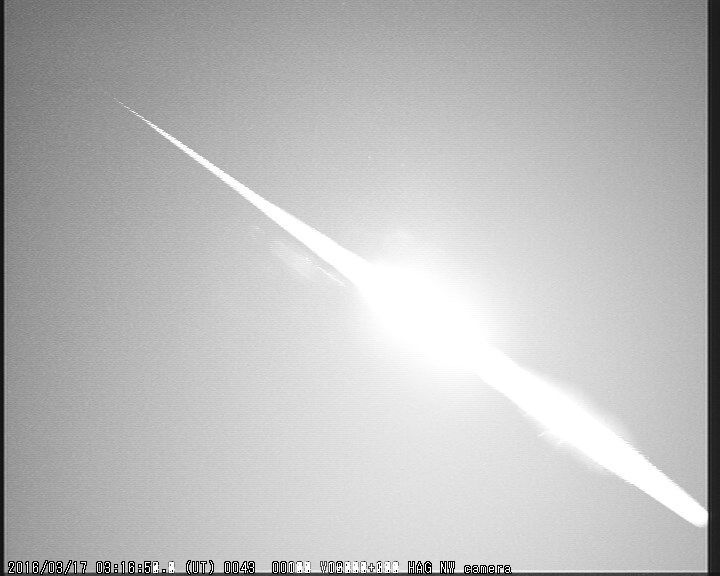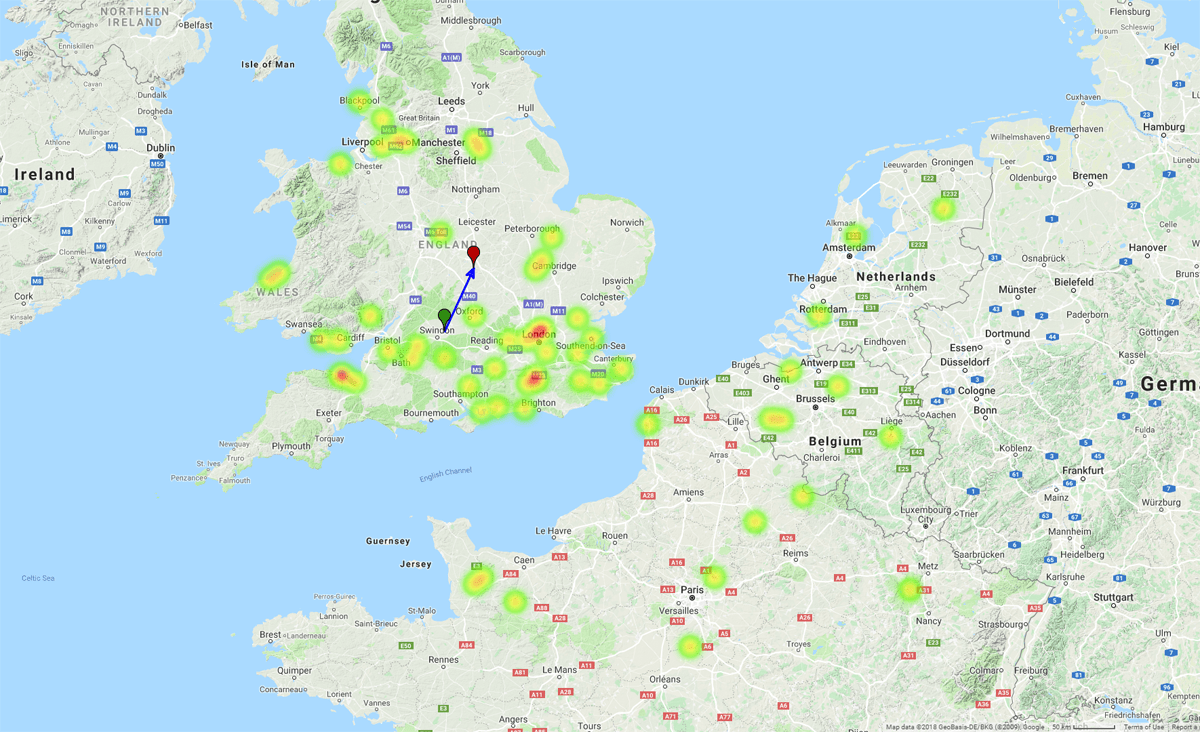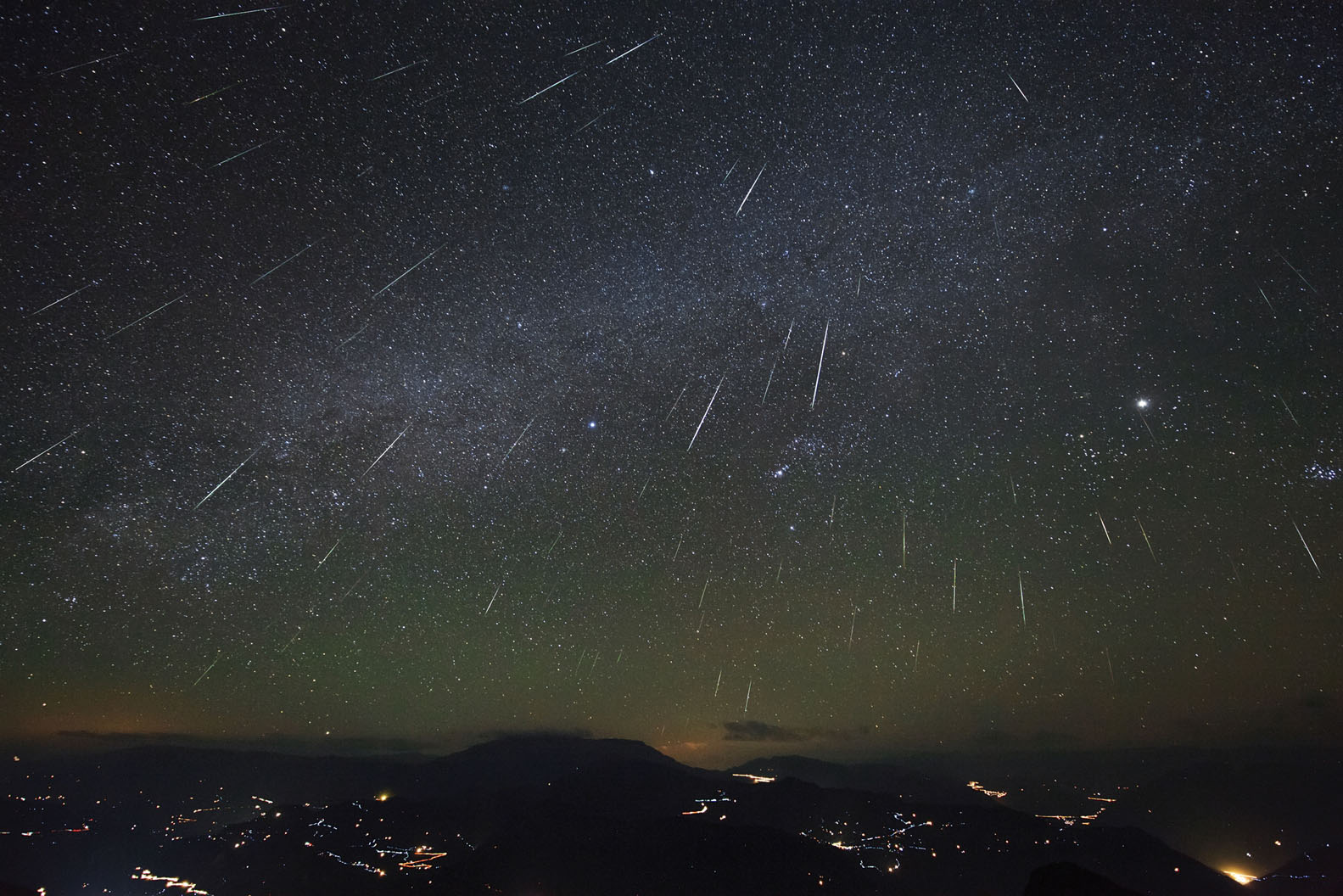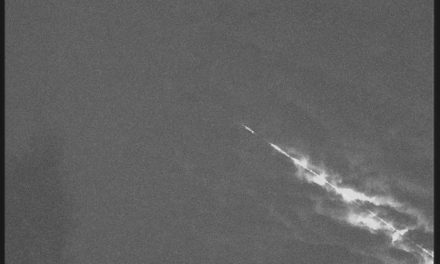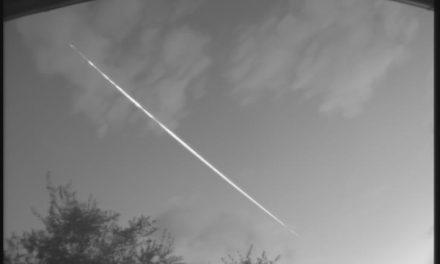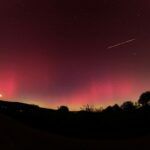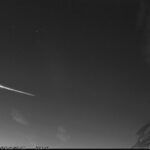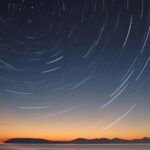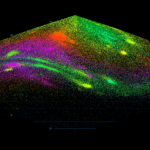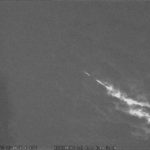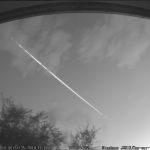Abstract
On March 17, 2016 in the early morning hours UKMON network (United Kingdom Meteor Observation Network) cameras recorded a bright fireball with an absolute magnitude of -12.5 ± 0.4m, whose atmospheric path began above the Dorset County and ended up above the Oxford County in the southern part of England. This fireball belonging to the Northern March gamma Virginids (IAU MDC #749 NMV) meteor shower was recorded from 8 cameras of the UKMON network. Atmospheric path of the bolide as well as heliocentric orbit of the meteoroid are analyzed within the article. The flight of the fireball, whose absolute magnitude was comparable with the brightness of the full Moon, was also observed by numerous random observers from the public in United Kingdom, Netherlands, Belgium and France. Numerical integration of the heliocentric orbit of the body and its clones was performed to find the potential parent body of the fireball and also the potential parent body of the meteor shower #749 NMV. However, in the comets (periodic, nonperiodic and lost) and asteroids database, the potential parent body of the fireball 20160317_031654 was not found.
Introduction
Fireball 20160317_031654 was recorded by UKMON network cameras on March 17, 2016 at 3h16m54.0 ± 0.1s UT. Due to the high brightness of the fireball were records from the cameras significantly saturated. The fireball flight was recorded by the following UKMON network stations (Fig. 1): Clanfield NW (Hampshire Astronomy Group, Steve Bosley), Church Crookham (Peter Campbell-Burns), Lockyer L1, L2 (Norman Lockyer Observatory, Dave Jones), Scotch Street C1 (Steve Hooks) and Wilcot NE, N (Richard Fleet).
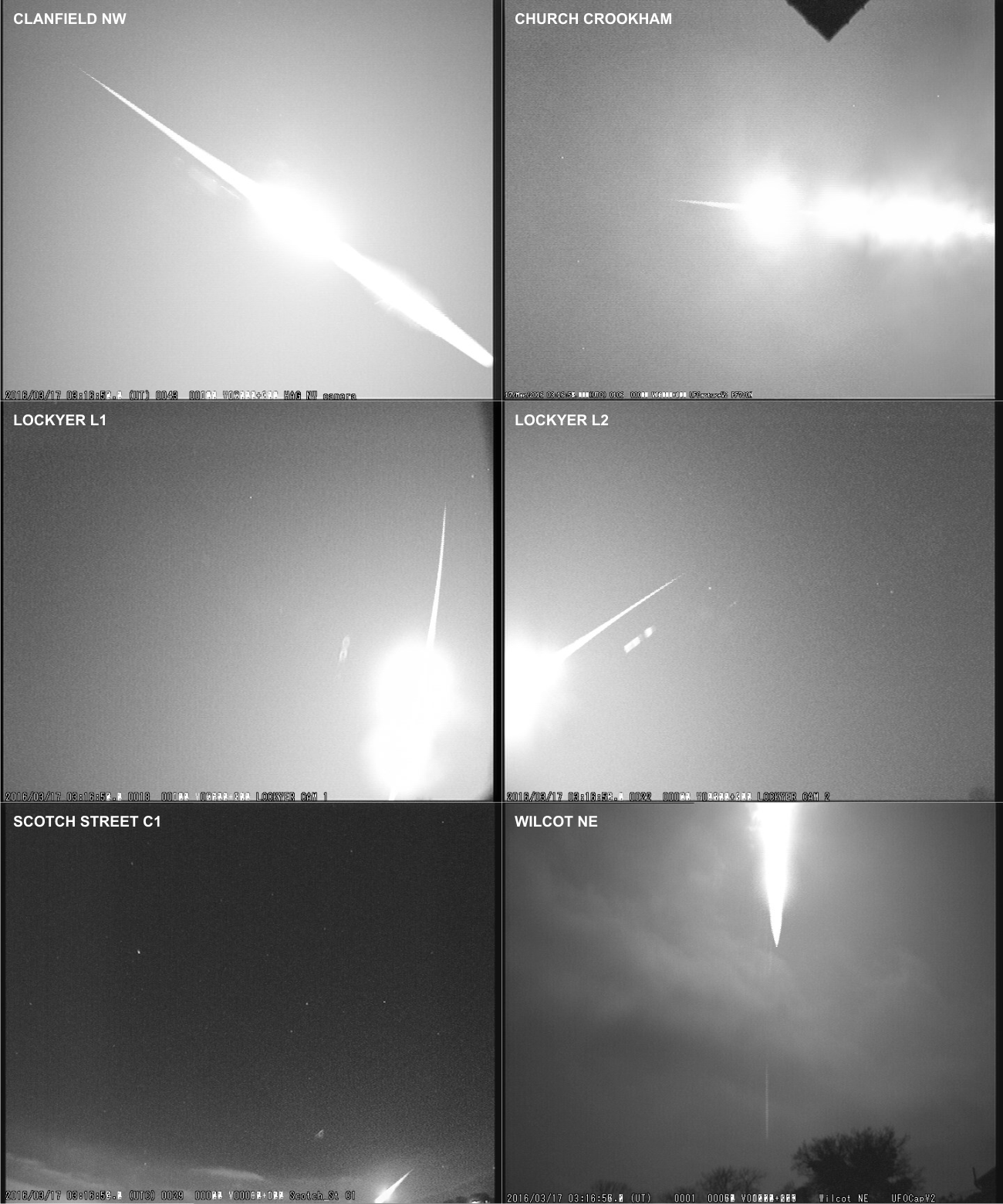
Fig. 1: Summary images of the fireball 20160317_031654 from stations Clanfield NW (Hampshire Astronomy Group, Steve Bosley), Church Crookham (Peter Campbell-Burns), Lockyer L1, L2 (Norman Lockyer Observatory, Dave Jones), Scotch Street C1 (Steve Hooks) and Wilcot NE (Richard Fleet). Within the summary images have been omitted saturated part of the sequence (saturated frames). Author: UKMON.
In this case, it was necessary to perform the astrometry of the recorded fireball manually. From NHM station (Natural History Museum, London), only a flash of flying fireball at the edge (or outside) of the field of view was recorded. The bolide was included in the EDMOND database (Kornoš et al. 2014a,b) with the designation 20160317_031654, which accurately identifies the observation time in the YYYYMMDD_HHMMSS (UT) format. The Northern March gamma Virginids meteor shower (IAU MDC #749 NMV) is one of the less active and less known showers. In the IAU MDC meteor showers database (Jopek et al. 2014), there are only two mean orbits of this shower (Jenniskens et al. 2016, 2017) that was taken from the CAMS network observations. The orbital elements of the shower mean orbit (Jenniskens et al. 2017, in parentheses Jenniskens et al. 2016) are as follows: vg = 38.3 (42.7) km/s, a = 1.54 (2.40) AU, q = 0.082 (0.071) AU, e = 0.935 (0.979), i = 21.1 (23.7)°, ω = 334.8 (332.5)°, Ω = 346.7 (338.9)°, coordinates of the geocentric radiant (J2000.0) are RA = 198.5 (189.1)°, DEC = -1.2 (3.0)°. The mean orbit was calculated from the 138 (13) individual orbits belonging to the shower. The possible parent body of the NMV shower has not yet been established.
Visual observations
Visual observations of fireballs are collected in the IMO database (http://fireballs.imo.net/members/imo_view/browse_events) and reports to this database are sent by visual observers from around the world. The report of fireball 20160317_031654 (Event 1027-2016, http://fireballs.imo.net/members/imo_view/event/2016/1027) was sent by 62 observers from United Kingdom, Netherlands, Belgium and France (Fig. 2). Many observers reported a terminal explosion, fragmentation or sound effects during the flight were not observed. The average relative brightness of fireball from visual reports was between -15m and -20m, but many observers reported fireball brighter than -20m.
Atmospheric path, radiant and heliocentric orbit of the fireball 20160317_031654
To calculate the atmospheric path of the fireball 20160317_031654 and the meteoroid orbit in the Solar System were used records taken from stations Lockyer L1, Clanfield NW a Scotch Street C1. The projection of the beginning of the atmospheric path was located at the coordinates N50.671666° W2.138888° near the city of Wareham (East Holme, Dorset County, UK), the height of the fireball at this time was 119.3 ± 0.1 km kilometers above the Earth’s surface. The end of the projection of the atmospheric path was located at the coordinates N51.810555° W1.504166° near the city of Witney (Crawley, Oxford County, UK), the height of the fireball at this time was 35.2 ± 0.1 kilometers above the Earth’s surface (Fig. 3). Fireball reached an absolute brightness of -12.5 ± 0.4m.
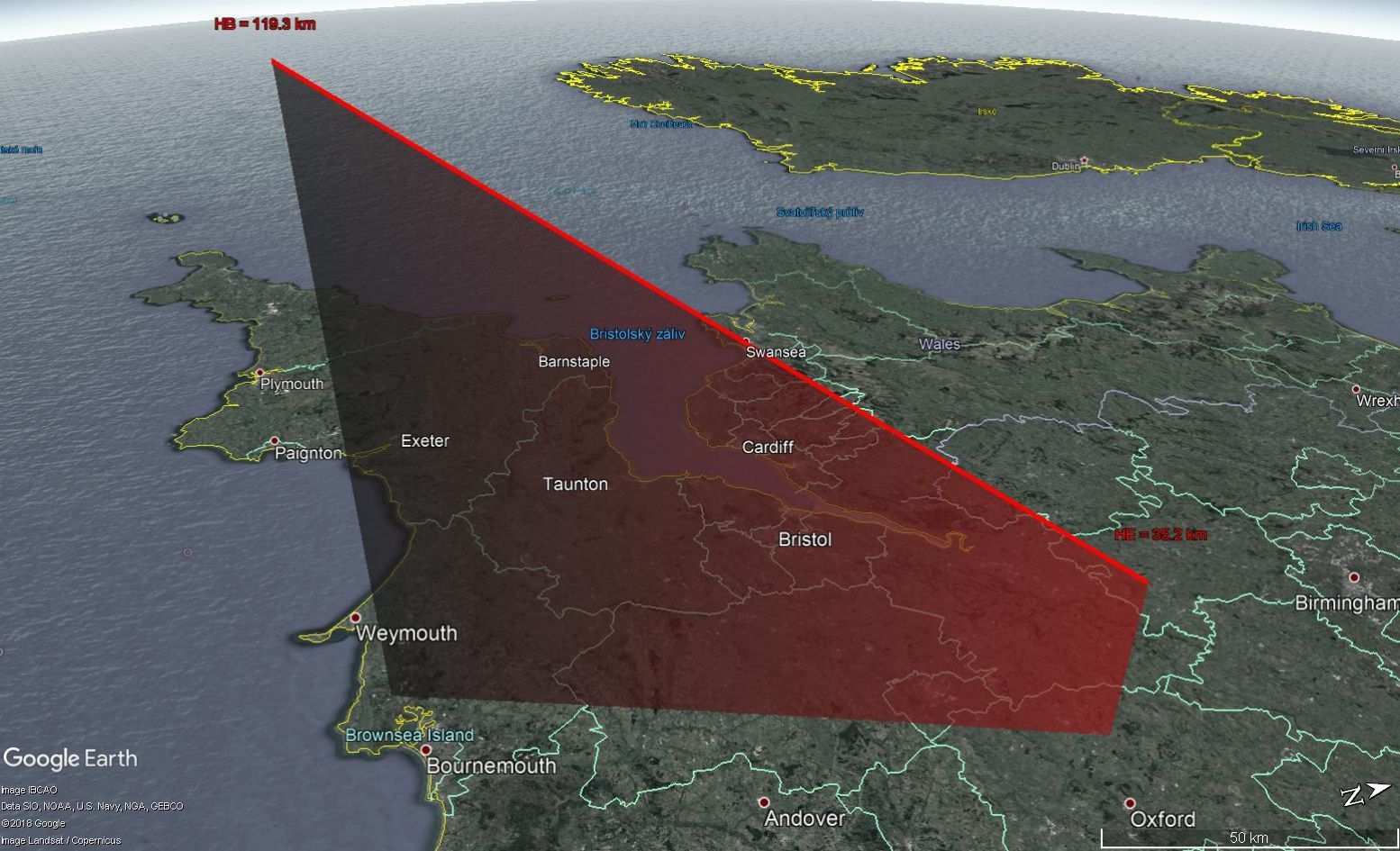
Fig. 3: 3D projection of the atmospheric path of the fireball 20160317_031654 on the Earth´s surface. Source of the map background: Google Earth, Google Inc.
It was a relatively fast meteor, the geocentric velocity of the meteoroid before entering the gravitational field of the Earth was 43.37 ± 0.03 km/s (including the deceleration effect), the orbital elements of the meteoroid orbit were as follows: a = 2.933 ± 0.123 AU, q = 0.0489 ± 0.0002 AU, e = 0.983 ± 0.001, i = 18.14 ± 0.03°, ω = 336.61 ± 0.01°, Ω = 356.7476°. Fireball belonged to the meteor shower Northern March gamma Virginids (IAU MDC #749 NMV) with geocentric radiant RA = 205.39 ± 0.11°, DEC = -6.42 ± 0.05° (Fig. 4). Orbital heliocentric parameters of the fireball orbit are shown in Table 1, geocentric orbit parameters are shown in Table 2.
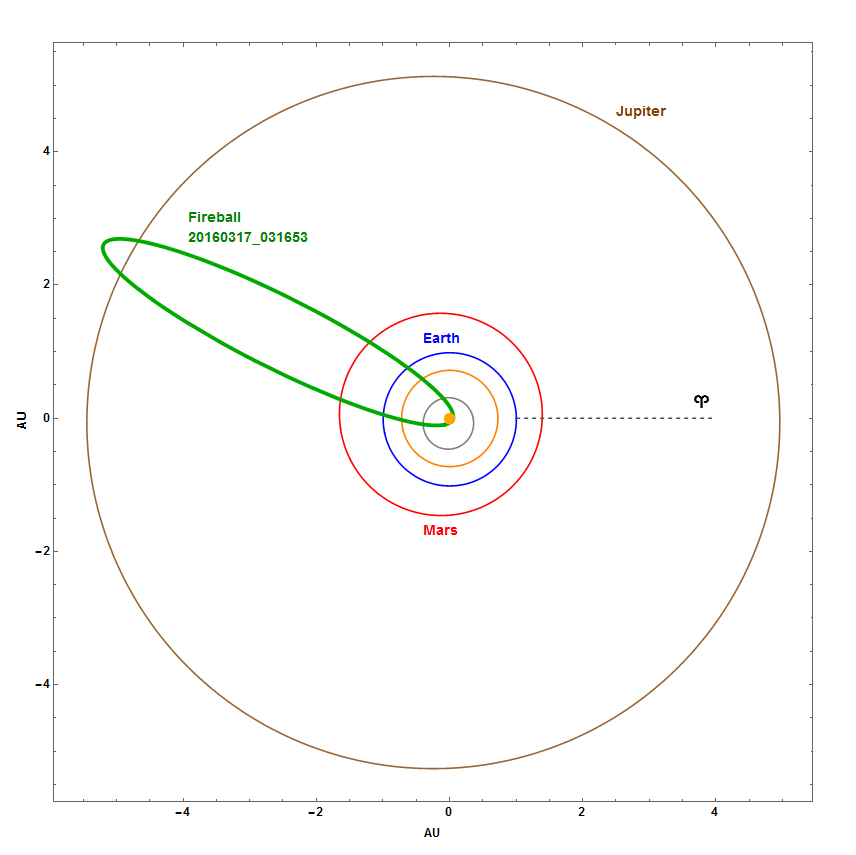
Fig. 4: Projection of the fireball 20160317_031654 orbit in the Solar System, including the effect of deceleration (polar coordinates system). Author: Jakub Koukal.
| Heliocentric orbital element | Fireball 20160317_031654 | Geocentric element | Fireball 20160317_031654 | ||
| Semi-major axis | a | 2.933 ± 0.123 AU | Geocentric velocity | vg | 43.37 ± 0.03 km/s |
| Eccentricity | e | 0.983 ± 0.001 | Initial velocity | vi | 44.73 ± 1.13 km/s |
| Perihelion distance | q | 0.0489 ± 0.0002 AU | Radiant right ascension | RA | 205.39 ± 0.11° |
| Aphelion distance | Q | 5.866 ± 0.246 AU | Radiant declination | DEC | -6.42 ± 0.05° |
| Argument of perihelion | ω | 336.61 ± 0.01° | Beginning height of the atmospheric path | HB | 119.3 ± 0.1 km |
| Longitude of ascending node | Ω | 356.7476° | Terminal height of the atmospheric path | HE | 35.2 ± 0.1 km |
| Inclination | i | 18.14 ± 0.03° | Absolute magnitude | amag | -12.5 ± 0.4m |
| Orbital period | P | 5.02 ± 0.32 y | Initial dynamic mass | md | 87.057 ± 15.287 kg |
| Heliocentric velocity | vs | 38.48 ± 0.03 km/s | Terminal velocity | vt | 19.82 ± 0.84 km/s |
| Tisserand´s parameter | TPJ | 2.03 ± 0.04 | Terminal dynamic mass | mdt | 0.139 ± 0.071 kg |
| Tab. 1: Heliocentric orbital elements (J2000.0) of the fireball 20160317_031654, calculated using software UFOOrbit (SonotaCo 2009), the effect of deceleration is considered in the calculation. | Tab. 2: Geocentric radiant, geocentric velocity, beginning and terminal height of the fireball 20160317_031654, calculated using software UFOOrbit (SonotaCo 2009), the effect of deceleration is considered in the calculation. | ||||
Physical properties of the fireball 20160317_031654
To estimate the initial weight of the body and its other physical properties, only the heliocentric orbit elements and the atmospheric path can be used in the case of fireball 20160317_031654. Because there is no spectrum available from the bolid flight, it is not possible to estimate its chemical composition. For the initial determination of the heliocentric orbit parameters, the Tisserand´s parameter in relation to the Jupiter was calculated (Eq. 1).

Depending on the value of the Tisserand´s parameter, the inclination of the orbit and the distance of the aphelion, the bodies can be divided into 5 groups (Borovička et al. 2005). Fireball 20160317_031654 has the Tisserand´s parameter TPJ = 2.03 ± 0.04, but the inclination of the orbit i = 18.14 ± 0.03° and the perihelion distance q = 0.0489 ± 0.0002 AU (Tab. 1). Fireball therefore belongs to the group 1/SA (Sun-approaching orbits: q < 0.2 AU) according to this classification. The density of the bodies in this group varies within a wide range (Kikwaya et al. 2011), from 1000 kg/m3 to 4000 kg/m3. The KB parameter (Ceplecha 1958) was used to determine a more accurate body density estimate. The KB parameter is a function of the material properties of the body and surface temperature (Eq. 2) and changes of this parameter are closely related to the meteoroid composition.

The value of the KB parameter for the fireball is 6.617 ± 0.035. According to classification criteria for groups of bodies (Ceplecha 1988), fireball belongs to the group C1 (a < 5 AU, i < 35°). However, the fireball is located on the boundary of groups C1 and D (KB <6.60), therefore the meteorode density is considered ρm = 800 kg/m3 (Kikwaya et al. 2011).
To calculate the initial mass of the meteoroid, an equation (Eq. 3) of the momentum transfer from the air molecules that collide with the meteoroid during the ablation phase (e.g. Ceplecha 1966) is used.

Calculation of the meteoroid deceleration was performed from data from Clanfield NW station (Fig. 5). The shape factor A = 1.209 is considered for the spherical body and the drag coefficient is considered Γ = 1.0 (Ceplecha 1966). The resulting initial dynamic mass of the fireball is for the given body density md = 87.057 ± 15.287 kg (Tab. 2).
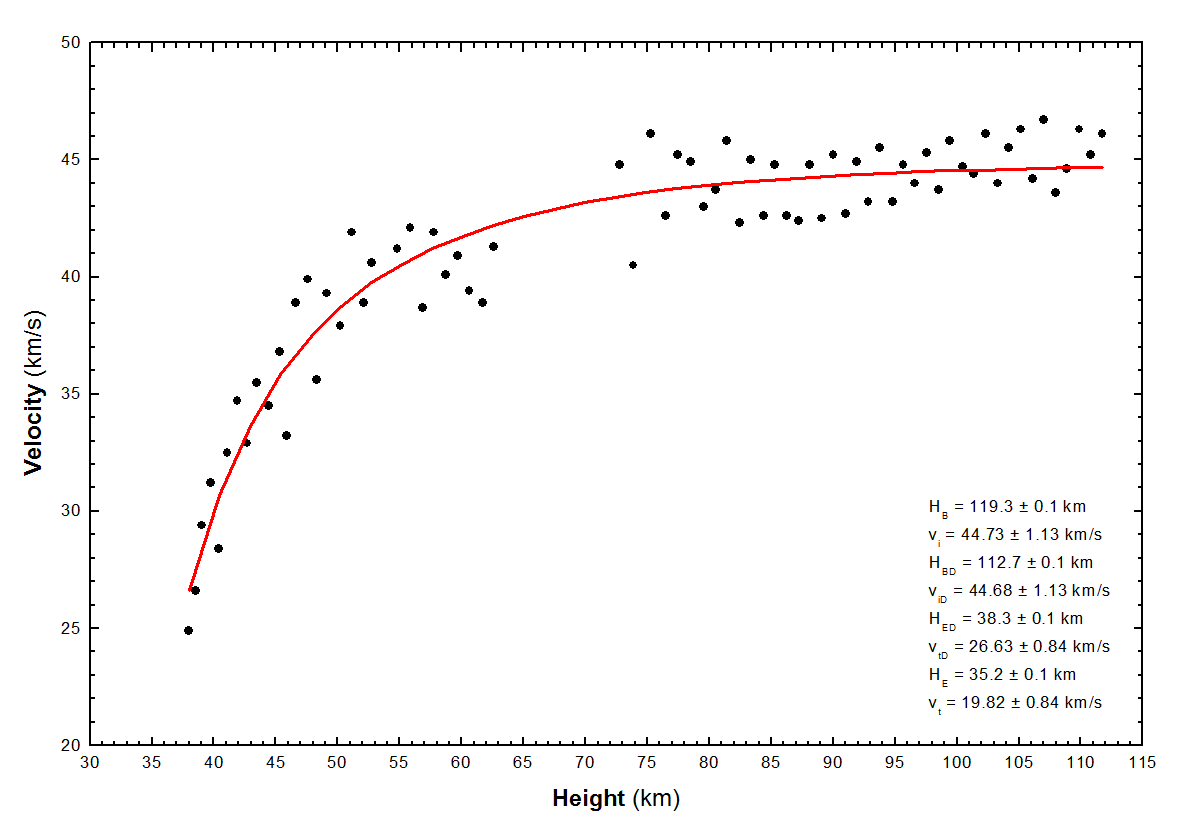
Fig. 5: Deceleration course of the fireball 20160317_031654 from Clanfield NW station. Author: Jakub Koukal.
Calculation of the photometric initial mass mph was not performed because the calculation procedure (Ceplecha 1966) is not suitable for use without further modifications. The resulting photometric initial mass values vary in many cases up to several orders from real values, or from the dynamic initial mass (Gritsevich 2008).
To calculate the body mass loss during the ablation phase, it is assumed that the drag coefficient Γ and the coefficient of the heat transfer Λ are constant. Under these circumstances, it is possible to simplify the calculation (Eq.4) of body mass loss during the ablation phase. However, this procedure is not suitable for bodies that penetrate into low heights (Ceplecha 1961). This procedure calculates the terminal dynamic mass of the fireball mdt = 0.139 ± 0.071 kg (Tab. 2).

Calculation of the mechanical strength of the meteoroid is based on the equality of the dynamic pressure and the mechanical strength of the body (Eq. 5) at the time of meteoroid fragmentation. The density of the atmosphere at a given fragmentation height is calculated according to the U.S. Standard Atmosphere 1976 model (NOAA, NASA and USAF 1976), including values at altitudes over 86 km (NASA 1976).

The moments of meteoroid fragmentation were determined from the course of the absolute brightness values of the fireball 20160317_031654 from the Clanfield NW station (Fig. 6). The mechanical strength values of the meteoroid at individual moments of body fragmentation are shown in Table 3.
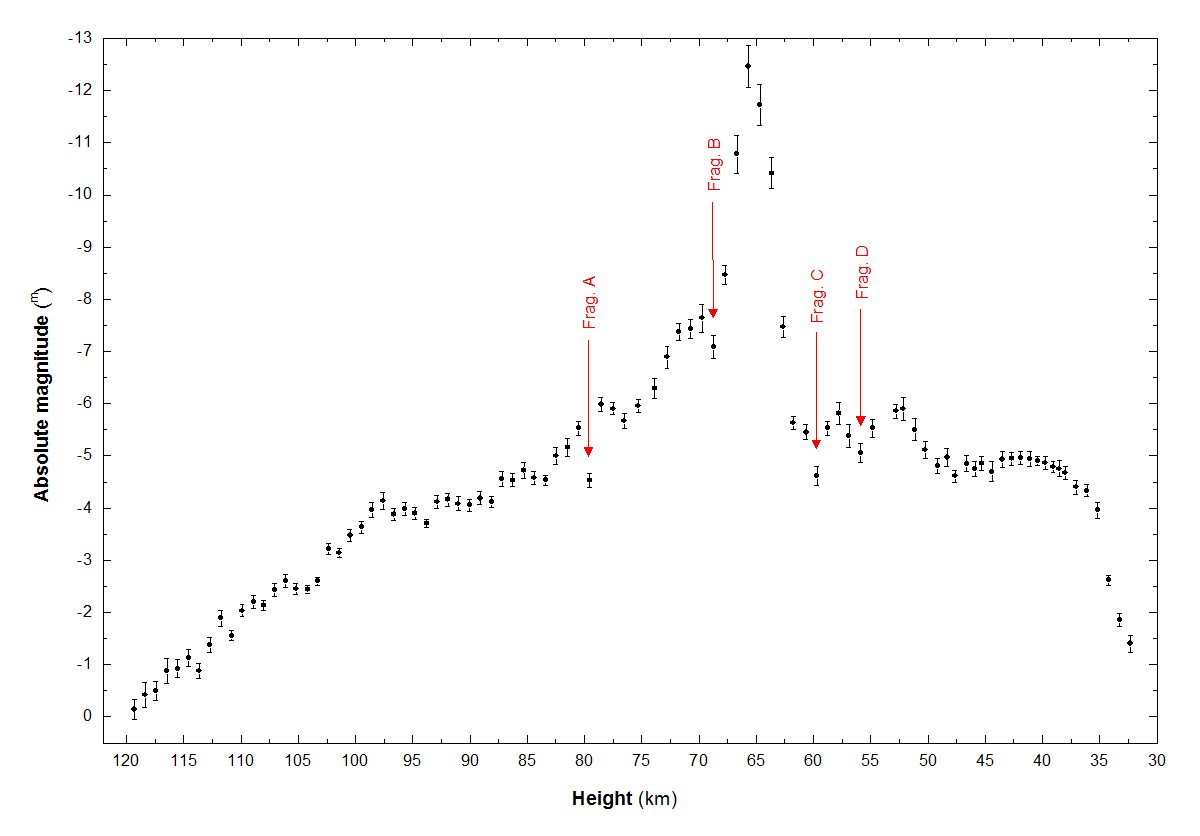
Fig. 6: Absolute brightness curve of the fireball 20160317_031654 from station Clanfield NW. The moments of fragmentation of the meteoroid are marked with symbols A-D. Author: Jakub Koukal.
| Fragmentation | H | ρa | v | σd | Δσd |
| km | kg/m3 | km/s | MPa | MPa | |
| A | 79.6 | 1.6878E-05 | 43.90 | 0.033 | 0.004 |
| B | 68.7 | 8.9339E-05 | 43.04 | 0.165 | 0.018 |
| C | 59.7 | 2.9972E-04 | 41.67 | 0.520 | 0.056 |
| D | 55.9 | 4.8335E-04 | 40.75 | 0.803 | 0.090 |
| Tab. 3: Mechanical strength of the meteoroid at individual moments of fragmentation. The mechanical strength of the fireball is determined by fragmentation at point B. | |||||
Origin of the fireball 20160317_031654
In order to look for the potential parent bodies of the fireball 20160317_031654, the heliocentric orbit reverse integration was performed. In addition, reverse integration of the heliocentric orbits of the fireball clones was performed. Reverse integration of the fireball orbit was performed using numerical-integration software SOLEX (Vitagliano 1997). This software is based on a 18th-order polynomial extrapolation method of the Bulirsh-Stoer type, the method of calculation is entirely based on the numerical integration of the Newton equation of motion. Due to the geometry of the fireball orbit, there are frequent approaches to the Solar system bodies and thus significant changes in orbital elements (Fig. 7, 8). Periodicity of changes in orbital elements (q, e, i) is approximately 1600 y.
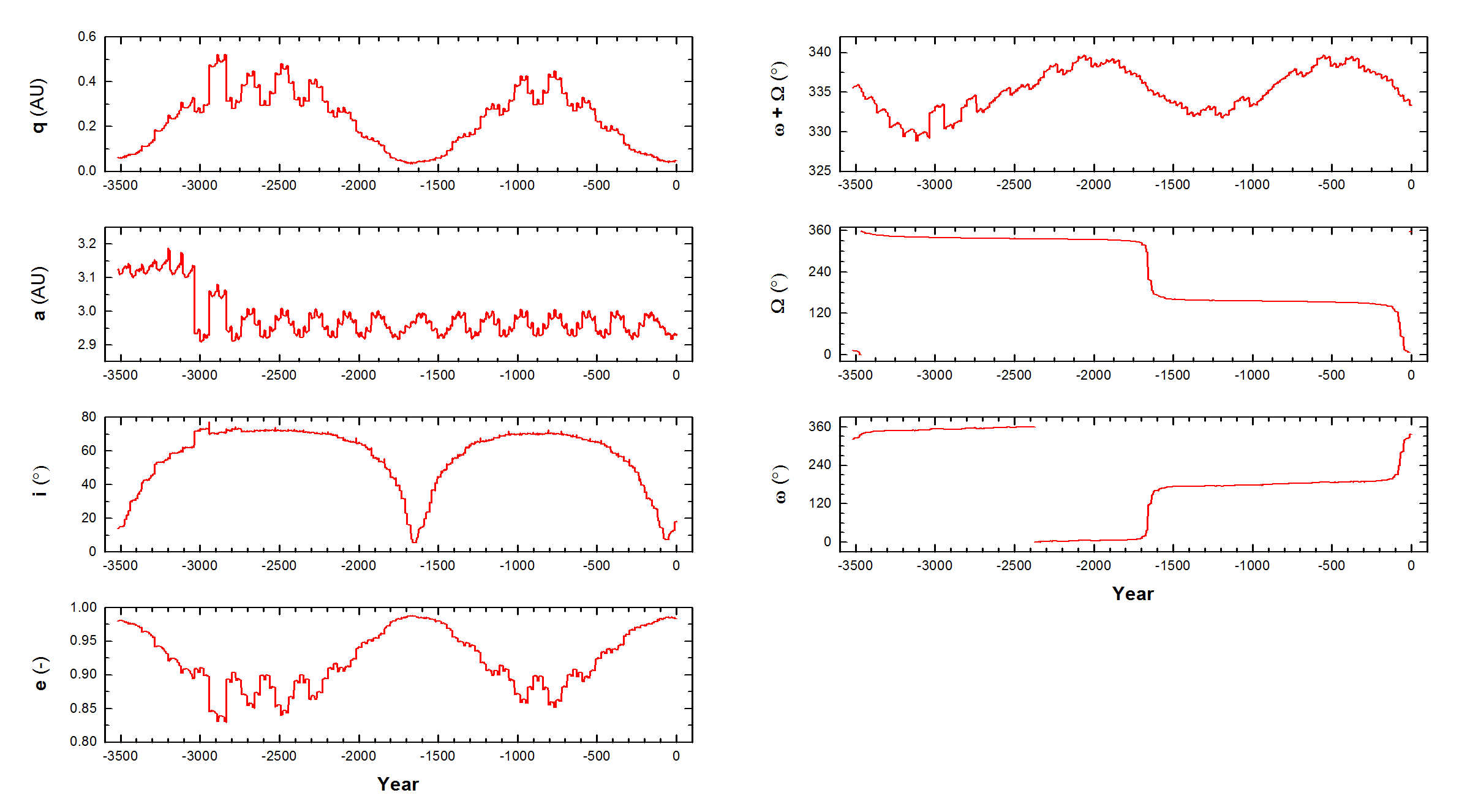
Fig. 7: Reverse numerical integration of the orbital elements of the fireball 20160317_031654 orbit. Column to the left (from the top): perihelion distance (q), semi-major axis (a), inclination (i) and eccentricity (e). Column to the right (from the top): sum of ascending node and argument of perihelion (peri + node), length of ascending node (node) and argument of perihelion (peri). Author: Jakub Koukal.
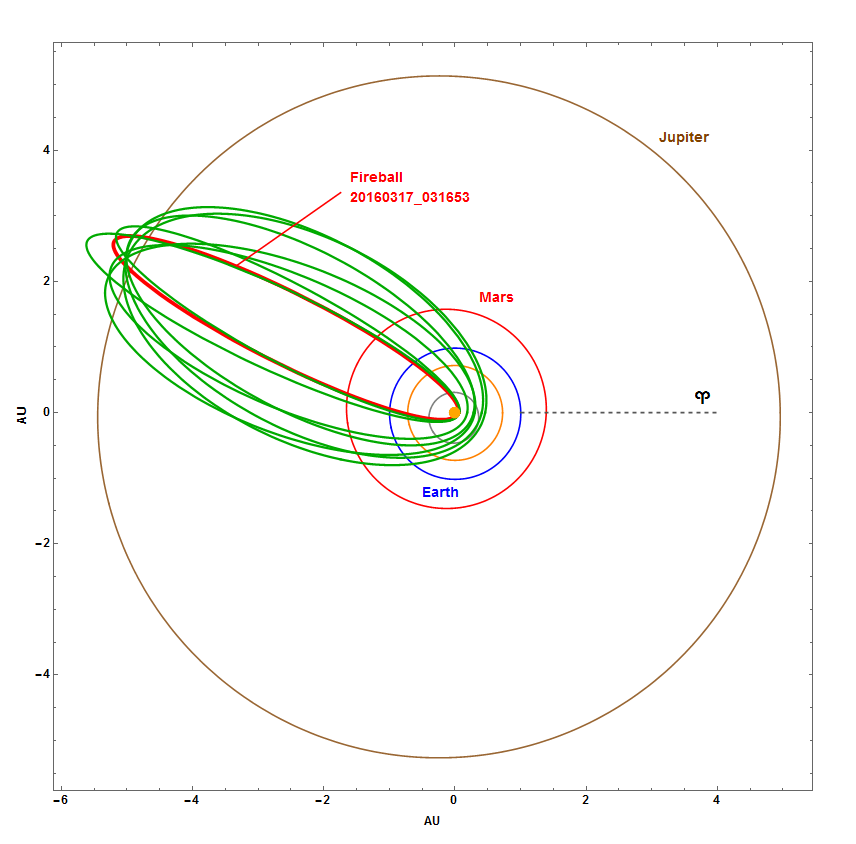
Fig. 8: Projection of the meteoroid orbits (reverse integration) in the Solar System with an interval of 500 years (polar coordinates system). Author: Jakub Koukal.
In addition, the heliocentric orbits reverse integration of the individual meteoroid clones along the fireball orbit was performed (Fig. 9). As a step for clone formation was determined ΔM = 15° (mean anomaly). A total of 24 clones were created spread across the entire circumference of the fireball orbit. Only 6 clones of the meteoroid have a stable orbit within the considered time interval (3500 y), including the meteoroid itself. The results of the reverse integration of the clone orbits indicate the probable age of fireball 20160317_031654 for a maximum of 3700 ± 100 y. However, in the comets (periodic, nonperiodic and lost) and asteroids database, the potential parent body of the fireball 20160317_031654 was not found.
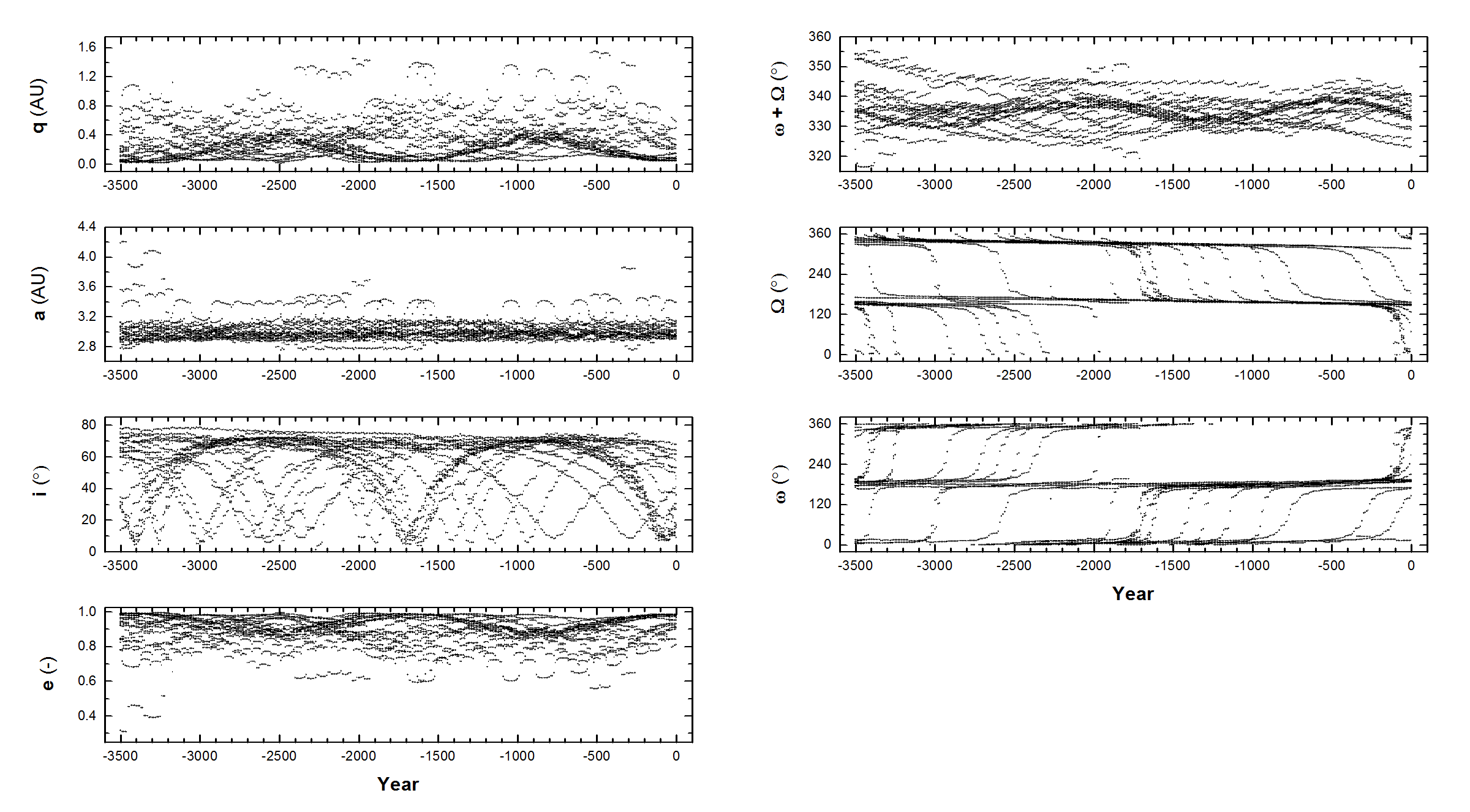
Fig. 9: Reverse numerical integration of the orbital elements of the meteoroid clones within the orbit of the meteoroid. Column to the left (from the top): perihelion distance (q), semi-major axis (a), inclination (i) and eccentricity (e). Column to the right (from the top): sum of ascending node and argument of perihelion (peri + node), length of ascending node (node) and argument of perihelion (peri). Author: Jakub Koukal.
Acknowledgement
I would like to thank to all following station owners, operators and observers from UKMON network for providing observations to the EDMOND database: Steve Bosley, Peter Campbell-Burns, Dave Jones, Steve Hooks and Richard Fleet. I would also like to thank to following institutions: Hampshire Astronomy Group, Norman Lockyer Observatory and Natural History Museum. And last but not least, I would like to thank to Richard Káčerek for his dedication to developing the UKMON network.
References
- Borovička J., Koten P., Spurný P., Boček J., Štork R. (2005). A survey of meteor spectra and orbits: evidence for three populations of Na-free meteoroids. Icarus, 174: 1, 15-30.
- Ceplecha, Z. (1958). On the composition of meteors. Bulletin of the Astronomical Institute of Czechoslovakia, 9, 154-159.
- Ceplecha Z. (1961). Multiple fall of Přibram meteorites photographed. Bulletin of the Astronomical Institute of Czechoslovakia, 12, 21-47.
- Ceplecha, Z. (1966). Dynamic and photometric mass of meteors. Bulletin of the Astronomical Institute of Czechoslovakia, 17, 347-354.
- Ceplecha, Z. (1988). Earth’s influx of different populations of sporadic meteoroids from photographic and television data. Bulletin of the Astronomical Institute of Czechoslovakia, 39, 221-236.
- Gritsevich M. I. (2008). Validity of the photometric formula for estimating the mass of a fireball projectile. Doklady Physics, 53:2, 97-102.
- Jenniskens P., Nénon Q., Gural P. S., Albers J., Haberman B., Johnson B., Morales R., Grigsby B. J., Samuels D., Johannink C. (2016). CAMS newly detected meteor showers and the sporadic background. Icarus, 266, 384-409.
- Jenniskens et al. (2017). Subscribed to Icarus.
- Jopek T.J., Kanuchova Z. (2014). Current status of the IAU MDC Meteor Shower Database. In Jopek T.J., Rietmeijer F.J.M., Watanabe J., Williams I.P., editors. Proceedings of the Meteoroids 2013 Conference, Aug. 26-30, 2013, A.M. University, Poznań, Poland, 353-364.
- Kikwaya J.B., Campbell-Brown M., Brown P. G. (2011). Bulk density of small meteoroids. Astronomy & Astrophysics, 530, A113, 17p.
Kornoš L., Koukal J., Piffl R., and Tóth J. (2014a). EDMOND Meteor Database. In Gyssens M. and Roggemans P., editors, Proceedings of the International Meteor Conference, Poznań, Poland, Aug. 22-25, 2013. International Meteor Organization, 23–25. - Kornoš L., Matlovič P., Rudawska R., Tóth J., Hajduková M. Jr., Koukal J., Piffl R. (2014b). Confirmation and characterization of IAU temporary meteor showers in EDMOND database. In Jopek T.J., Rietmeijer F.J.M., Watanabe J., Williams I.P., editors. Proceedings of the Meteoroids 2013 Conference, Aug. 26-30, 2013, A.M. University, Poznań, Poland, 225-233.
- NASA (1976). The 1976 Standard Atmosphere Above 86-km Altitude. Edited by R. A. Minzner, Goddard Space Flight Center, NASA SP-398, October 1976.
- NOAA, NASA and USAF (1976). U. S. Standard Atmosphere. NOAA-S/T 76-1562, Washington, D.C., October 1976.
- SonotaCo (2009). A meteor shower catalog based on video observations in 2007-2008. WGN, Journal of the International Meteor Organization 37:2, 55-62.
- Vitagliano A (1997). Numerical Integration for the Real Time Production of Fundamental Ephemerides over a Wide Time Span. Celestial Mechanics and Dynamical Astronomy, 66, 293-308.

